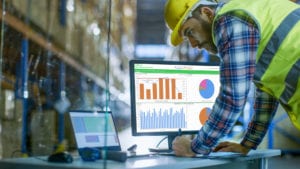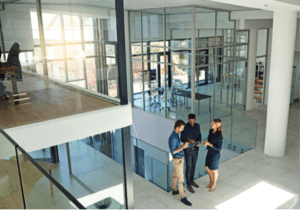In the times of the ‘new normal’, businesses will adopt new operating models, requiring design engineers to rethink conventions and adapt to new ways of designing buildings.
The demands from design engineering have changed both suddenly and drastically, as the whole world is struggling to meet the demands presented by the ‘new normal’ in the COVID world.
Businesses won’t run the way they ran before. It is now imperative to take note of these evolving business practices, to build resiliency together, and to leverage existing technologies for redesigning a new world. New business practices are being adopted by enterprises and there are emerging trends which will reshape the places and buildings that we live, work and recreate in.
 What happens to the regular offices?
What happens to the regular offices?
That’s a question worth pondering over, as a sizeable part of the modern-day workforce has had to shift, very suddenly, to a work-from-home culture. Some large companies have even asked employees to work from home indefinitely. Consequently, with the rise of partial or complete work from home practices, the demand for large city offices may decline. For instance, during a recently conducted Schneider Electric survey of over 100 design offices, more than 80% of respondents answered that they will at least have a partial work from home policy. But that’s only one side of the story for not every office can have employees working from home. Big and small enterprises, industries, and service sectors need people to be at their workstation, in the field, or in the office. And hence, we will see new ways of operating evolve.
New operating models and occupancy challenges.
There will indeed be a shift from the earlier practice where everyone must report to the office. Enterprises will more likely adopt a mix of various operating models, and part of the workforce may work from home. Offices may introduce staggered attendance and variable working hours to avoid overcrowding of employees. Shift systems may be employed. Companies may decide to have one-third of the workforce in office at any point of time as they adhere to social distancing guidelines. These requirements will have direct impact on how office spaces are defined.
It must be ascertained how the spaces can be best utilized to ensure employee safety, respect physical distancing and ensure a productive atmosphere. Occupancy challenges would impact all types of public infrastructure from residential buildings to malls and theaters to offices and industries and it would require serious thought while designing public spaces.
Workplace redefined: The office is dead – long live the office!
Are we going to have two kinds of workplaces? That’s an important question because employees may have to work from home or may have to report at work as needed. Given the scenario, people will more likely choose to have an office set-up at home. For those who are going to offices, open plan structures may be a thing of the past and are likely to be replaced by deep work chambers for ensuring safer health, focused work and higher productivity. Thus, enterprises would have to redesign office layouts and rework office spaces while embedding technologies that allow for maximal use of space, while keeping safety. A fitting example of technology redefining work places is the creation of the MyCampus application for Microsoft France Campus. Factoring in the necessities of current times, the application was created by Microsoft in partnership with Schneider Electric to help employees navigate through the campus with minimal hassle, check availability remotely and ensure best-in-class safety & distancing.
Going contactless.
One of the biggest changes in business practices would be that once people come together to work, they will be working with minimal contact. New business practices will be built around a contactless working culture. To support this, companies will need to leverage digital technologies such as data center based IoT, automation technologies, and security technologies to go contactless as much as possible. This will not only highly regulate spaces and secure access but building in smart systems would also add another layer of protection to health.
Contactless navigation within the office premises with the use of an app or card is already possible. Almost 70% of a building can be managed remotely through connected room solutions. A sensor-based network supported by AI and predictive analyses can also inform employees of vacant spaces (such as the dining rooms), raise crowding alerts and even help plan employee office-day schedules together with HR. Such technology is the MyCampus app which is based on Schneider Electric’s Ecostruxure Workplace Advisor technologies which enables employees to find parking spaces, book meeting rooms, and even find colleagues in the office premises.
Health, sanitization and public health within the design.
It’s not going to be only about clean offices. Sanitized environments are the new need which is going to drive numerous business practices. Periodically sanitizing workspaces would become the norm. New standard operating procedures may be implemented, mandating the use of masks and maintaining social distancing for the employees. Health check-ups, especially thermal checks, are likely to be a part of the daily routine, impacting the flow of entry into offices and therefore organization, but also on the design and sizing of the building and its transport facilities.
Many other interventions would require us to look at our existing systems and practices through the lens of disinfection. Indoor air without proper ventilation has a high risk of air borne exposure. Air conditioning systems, which are one of the most common agents of re-circulating infections, would have to be armed with the right HEPA filters and need high value maintenance. The complete spatial dynamics of the workplace will undergo a huge change, from the access of staircases and elevators to office rotation, employee seating and movement plans.
New ways of collaborating.
Open communications and collaboration are critical aspects for any business enterprises to run. While digital technologies will definitely be leveraged for collaboration between stakeholders and amongst teams as well for training and up-skilling of workforce, often the virtual world does not deliver the same human touch to conversations. It is here that enterprises will look towards finding more ways to collaborate and make the experience as realistic as possible.
Changing with the times, design engineers along with all industry experts are leveraging online mediums and various video conferencing platforms for connecting with their customers to manage the execution of the project. Major discussions are happening online, while execution and physical monitoring remains site-based.
How will we commute to work?
Before the pandemic hit the world, the narrative was to move towards public transport and bring down the number of self-owned vehicles. In a matter of months, this has been reversed with a tremendous shift towards traveling using our own modes of transport. Enterprises are rethinking the many aspects related to travel. Do they have the right parking space? Can they provide transport facilities?
Overall, despite tremendous loss due to the pandemic, design offices need to explore and deeply understand these business practices to identify what will be sustained for a longer run and how this will impact design. The crisis has a profound learning and opportunity for improvements to offer. New systems and practices can be implemented to mitigate or absorb the effects of a potential similar future crisis of this scale and intensity.
As part of Schneider Electric endeavors and together with our partners, various initiatives are underway including Webinars deliberating upon various developments in the industry and their impact on design, markets and consumer habits. Our Partner Portal features specific online training on various subjects including remote working but also articles on preparing buildings for low-occupancy periods together with the action plans required to resume to a smooth transition to normalcy.
You can join the Schneider Electric partner portal and learn more by clicking here.



